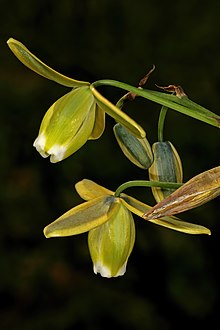Albuca cooperi
 From Wikipedia - Reading time: 5 min
From Wikipedia - Reading time: 5 min
| Albuca cooperi | |
|---|---|

| |
| Scientific classification | |
| Kingdom: | Plantae |
| Clade: | Tracheophytes |
| Clade: | Angiosperms |
| Clade: | Monocots |
| Order: | Asparagales |
| Family: | Asparagaceae |
| Subfamily: | Scilloideae |
| Genus: | Albuca |
| Species: | A. cooperi
|
| Binomial name | |
| Albuca cooperi Baker
| |
| Synonyms | |
|
Albuca flaccida Baker 1873 | |
Albuca cooperi is a species of small, perennial, bulbous plant in the asparagus family.
It is native to the western parts of South Africa. It occurs in sandy, sometimes limestone, areas, from the Richtersveld in the north, southwards to the Cape Peninsula, and eastwards through the Great Karoo, to Willowmore.[1][2]
Description
[edit]A geophyte reaching 30–60 cm in height. The bulb is ovoid, usually with some thin fibres around the top, made from the persistent remnants of the leaf-tunics. The species bears only 2-to-4 smooth, slender, linear, channeled leaves. The leaves are clasping and warty at the base.
The slender peduncle terminates in a lax raceme. The flowers are drooping ('nodding') and pale yellow with broad green central stripes. In some cases, the septa has a faint crest.[3][4]
References
[edit]- ^ "Albuca cooperi Baker". Plants of the World Online.
- ^ "Threatened Species Programme | SANBI Red List of South African Plants". redlist.sanbi.org.
- ^ Manning, J.C. and Goldblatt, P. 2012. Plants of the Greater Cape Floristic Region 1: The Core Cape Flora. Strelitzia 29. South African National Biodiversity Institute, Pretoria.
- ^ "Pacific Bulb Society | Albuca A-F". www.pacificbulbsociety.org.
 KSF
KSF